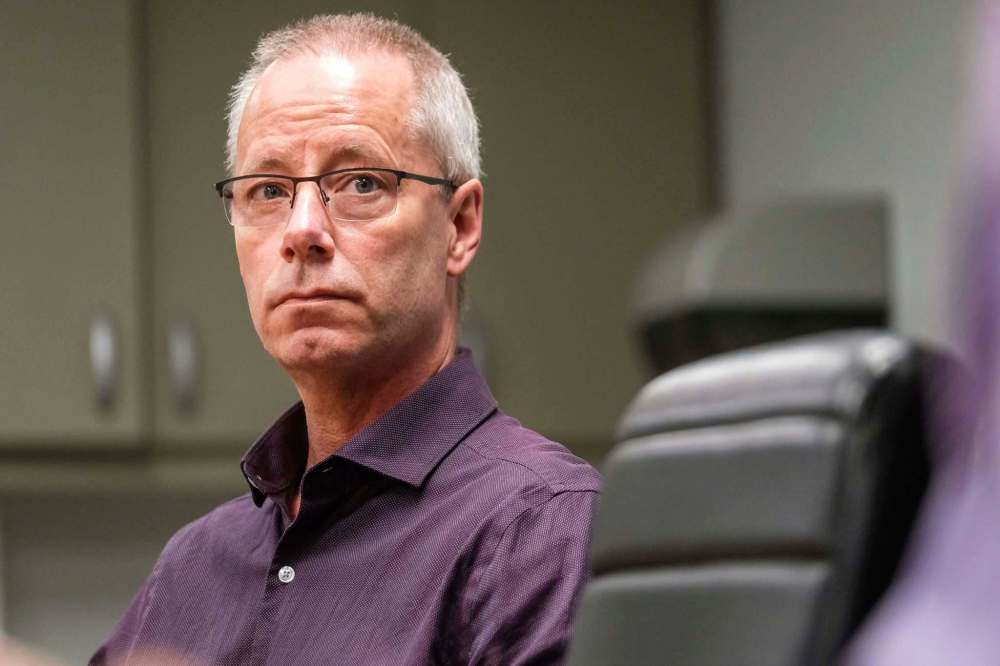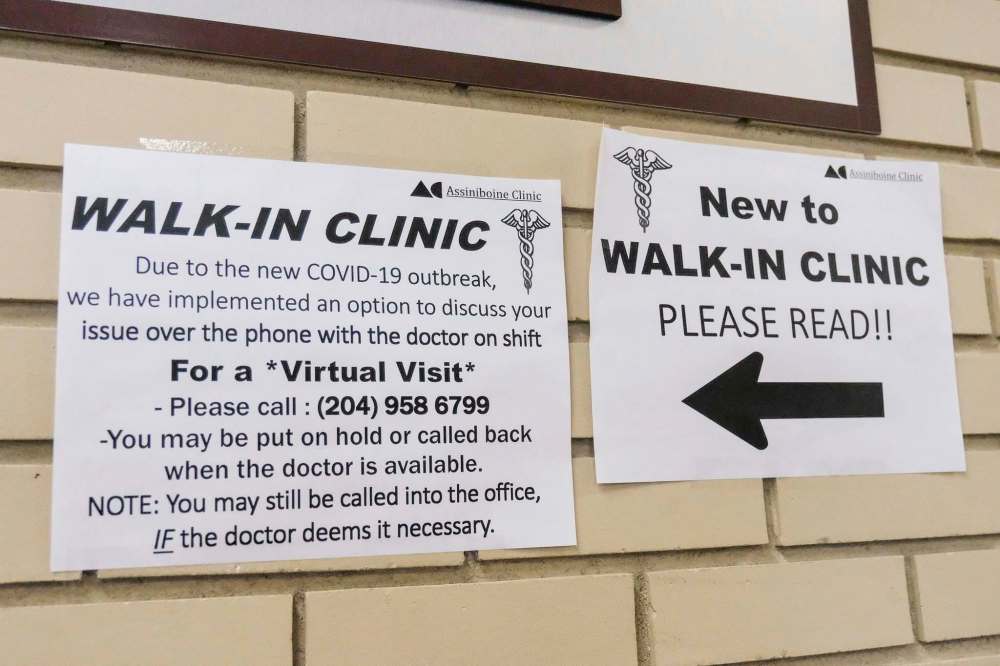Virtual visits help keep clinic safe
Doctors seeing patients over the phone first during pandemic
Advertisement
Read this article for free:
or
Already have an account? Log in here »
To continue reading, please subscribe:
Monthly Digital Subscription
$0 for the first 4 weeks*
- Enjoy unlimited reading on winnipegfreepress.com
- Read the E-Edition, our digital replica newspaper
- Access News Break, our award-winning app
- Play interactive puzzles
*No charge for 4 weeks then price increases to the regular rate of $19.00 plus GST every four weeks. Offer available to new and qualified returning subscribers only. Cancel any time.
Monthly Digital Subscription
$4.75/week*
- Enjoy unlimited reading on winnipegfreepress.com
- Read the E-Edition, our digital replica newspaper
- Access News Break, our award-winning app
- Play interactive puzzles
*Billed as $19 plus GST every four weeks. Cancel any time.
To continue reading, please subscribe:
Add Free Press access to your Brandon Sun subscription for only an additional
$1 for the first 4 weeks*
*Your next subscription payment will increase by $1.00 and you will be charged $16.99 plus GST for four weeks. After four weeks, your payment will increase to $23.99 plus GST every four weeks.
Read unlimited articles for free today:
or
Already have an account? Log in here »
Hey there, time traveller!
This article was published 28/03/2020 (2088 days ago), so information in it may no longer be current.
Assiniboine Medical Clinic is normally a bustling place, the largest fee-for-service family practice facility in the city. But the last two weeks have been far removed from normal.
The once crowded hallways and waiting rooms are mostly empty. Security is tight.
Access to the building at the corner of Booth Drive and Lodge Avenue is limited to one entrance on the complex’s north side and visitors are greeted and screened by a primary care nurse wearing protective gear.

You want a walk-in appointment? There’s a sign advising you to return to your vehicle to make a phone call which will connect you to one of the clinic’s physicians — a virtual appointment if you will.
During a global pandemic, with caution ratcheted to an extreme, it’s the price you pay. But an absence of people on the premises doesn’t mean patients aren’t getting treated.
For Dr. Michael Stephensen, a general practitioner and one of the clinic’s 30 physicians, the workload is roughly the same as it was two weeks ago when the provincial government approved tariffs for virtual visits.
“We have three levels of screening,” says Stephensen. “… All of our visits here in the clinic that occur in the office first occur between the patient and the physician on the phone. So that physician would screen them. And when they come to the clinic, whether they were told to come by a physician or whether they’re coming for another reason — for example to go to the lab — they’re stopped at the front door… If they are not safe to come in or are in the wrong facility or the wrong purpose, then we direct them in the right direction.”
On a typical day, Stephensen arrives at work by 6:30 a.m., and sees patients from 7 a.m. until approximately 5:30 p.m. When he leaves for home at 6 p.m., he’ll take 30-minute break before another round of patient phone calls that will last until 11 p.m.
The difference is only three or four were in-person visits, with another 30 or more more handled via telephone or one of an assortment of web-based alternatives.
Keeping things simple has had immediate results. Most patients, especially those less tech-savvy, prefer a telephone consult. Patients can also send pictures of specific medical conditions to their physician’s electronic medical record and often the problems can be expedited without an in-person visit.
“We started with the phones,” says Marc Desjardins, the clinic’s executive director. “The reason why most of our visits are done over the phone rather than video chat or conferencing is because it’s simple.
“So when the province announced on the 15th of March that virtual visits were now a thing and we could be using them to their upmost, we made the decision that we’ll do phones first and see what we can develop later. And most people have been fairly receptive to phone calls rather than anything more complex.”
Under the new system, virtual appointments always occur first. Even if a patient needs to be seen in person doctors can do the majority of the work on the phone.
Appointment lengths, Stephensen says, are not really affected.
“In the end, it seems to be self-working,” he says Stephensen. “People understand the system so you spend the time you need and it works out.”
Observing the new rules about social distancing are now routine.
“We were actually looking to do some form of virtual care on an uninsured basis prior to this,” says Desjardins. “With regards to how it’s changed my job — I’d say pretty radically overall. Because in trying to enforce social distancing as I talk with every physician in the building, it’s my goal to keep my distance.
“So we’re doing a lot more phone calls, virtual interactions with the physicians and staff. We’ve gone as far as to allow our front-line staff to work from home in many cases, which is not what you’d expect from a receptionist — we’ve made it work.”
Safety measures needed to help curb the pandemic don’t stop at social distancing. Nurses will mask patients making in-person visits if they are concerned and although the clinic has a cleaning service, other members of the support staff are involved in wiping down furniture at regular intervals.

The details are crucial.
“These procedures that we’re doing are very important because this can take off and get much worse,” says Stephensen. “And it happens rapidly when it happens. But it isn’t new and so we’ve dealt with this all along and it’s also not magic. If we take the appropriate precautions it should work.
“I assist in surgery a fair amount — we garb properly and we do not pass infections onto patients with large open wounds. So it works. We just have to do it properly. The public health and Dr. (Brent) Roussin have been fantastic in their management of this and all we have to do is follow the information that’s given us and it should go well.”
Desjardins says virtual appointments would be helpful in a post-pandemic world.
“I still look at three months, four months, six months, 12 months (down the road),” he says, noting there has been a decline in the number of patients of between 20 and 30 per cent during the same two-week period a year ago. “What are we going to look like then? While it’s been great having these virtual visit tariffs available to us, we would love to see if that continues after the pandemic.
“Manitoba Health has been pretty specific that this is an emergency measure that they’re not intending to continue. But we’d love if it would continue and I think we’re still intending to continue with after anyway, as an uninsured service or as a service we can provide for patients because it has been very well received.”
The benefits to mobility-restricted patients or middle-aged children who would normally need to take time off to bring an elderly parent to a doctor’s office are pretty obvious.
“When you have a patient living a hour outside of town and just needs their blood pressure checked and a prescription renewed, we can send them to the local pharmacy to get their blood pressure checked and provide them with accurate and complete care without them having to drive,” says Desjardins.
Another impact of the pandemic is a reluctance to get medical advice. Desjardins notes there has been a 20 to 30 per cent decline in the number of patients from the same two-week period a year ago.
“Coronary artery disease, diabetes and asthma and seizures don’t stop during a pandemic,” says Stephensen. “That’s our concern that the patients continue to get those things looked after.”
mike.sawatzky@freepress.mb.ca
Twitter: @sawa14

Mike Sawatzky
Reporter
Mike has been working on the Free Press sports desk since 2003.
Our newsroom depends on a growing audience of readers to power our journalism. If you are not a paid reader, please consider becoming a subscriber.
Our newsroom depends on its audience of readers to power our journalism. Thank you for your support.

